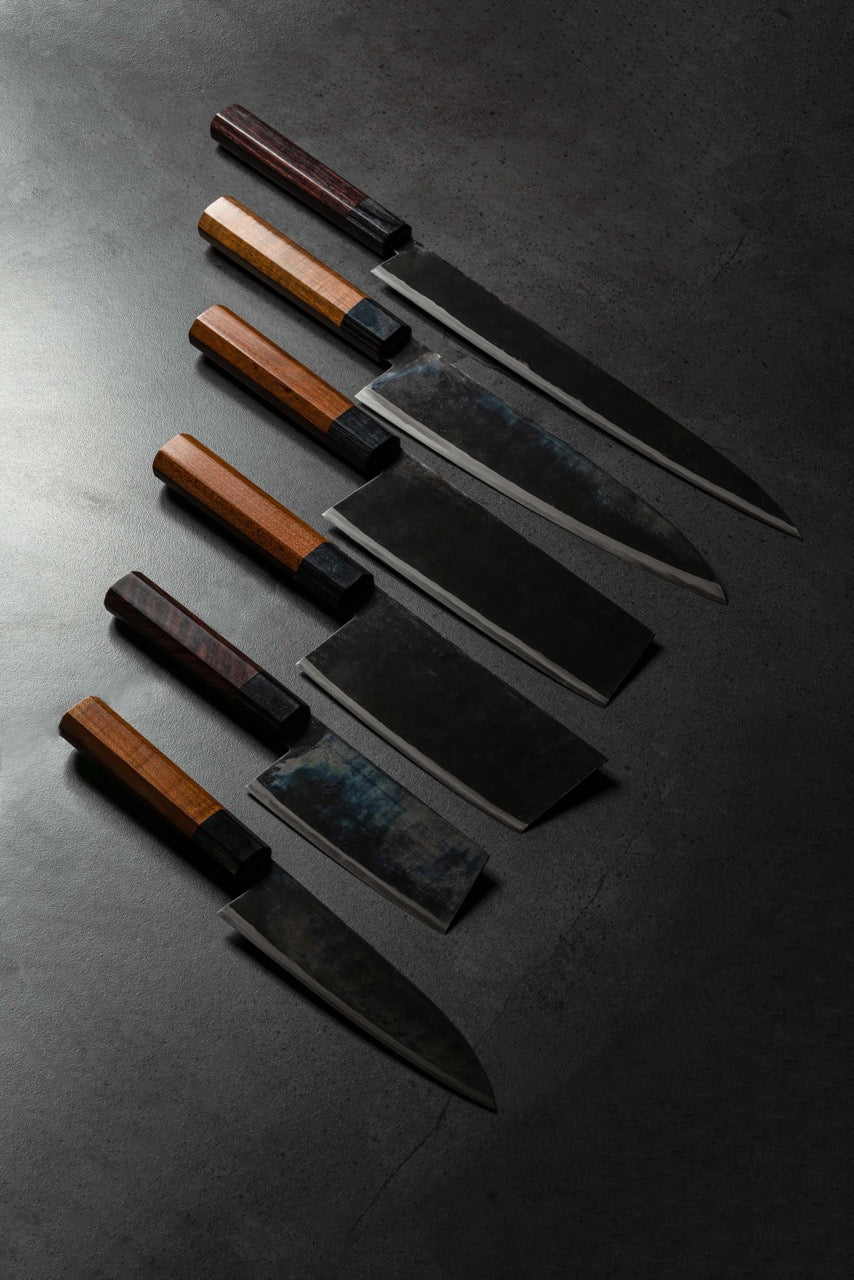
Enn Damascus Kisuke Manaka Aogami #1 Kiritsuke Gyuto 270mm Tsuchime Kurouchi
Please note
Each handle is unique and may feature distinct variations, such as different shades or colors in the buffalo horn, which is part of its authentic, handcrafted character.
Store availability
*Transfer available between stores, contact us at info@staysharpmtl.com or 514-503-1185 (MTL) / 418- 440-7770 (QC)
Description
Manaka Hamono Tanrenjo (間中刃物鍛錬所) was founded in 1872 in Kasukabe City, Saitama Prefecture. Kisuke Manaka (real name Shunsuke Manaka) represents the 5th generation of Manaka blacksmiths even though he is not a direct descendant of the lineage.
He became interested in blacksmithing through marriage to the Manaka family. His father-in-law (4th generation) did not master the art of forging: he was a knife dealer and relied on the reputation of the Manaka forge to sell blades that were not completely hand-forged. Since his father-in-law could not teach him the art of blacksmithing, Kisuke Manaka taught himself using the tools and blacksmithing books that his grandfather-in-law (3rd generation) had left behind. He learned to master all aspects of blacksmithing. Today, he is best known for his mastery of the Warikomi method, which he has even extended to stainless steels like ATS-34 and ZDP-189. His "Enn Damascus" series of knives, with a core of Aogami #1 covered with a mixture of Aogami #2 and soft iron, is his most prestigious and reflects the full extent of his talent.
“ Kisuke's Aogami No. 1 has a better bite than Aogami No. 2. The carbon content is about 1.35%, which is 0.2% higher than Aogami No. 2, which makes it possible to produce a biting sharpness that was not possible with Aogami No. 2. “ - manaka-hamono.com
www.manaka-hamono.com
Kiritsuke Gyuto is a cross between traditional kiritsuke and gyuto. The profile of the cutting edge is generally straighter and the tip is cut, similar to the kiritsuke, while the double bevel is characteristic of the gyuto. Kiritsuke Gyuto acts as a chef's knife in your kitchen and can do most of the tasks. It is usually found between 210 and 270 mm.
Tips for best results
Make sure your knife will deliver its absolute best by having it professionally sharpened at least once a year. Please note that our meticulously handcrafted Japanese knives are – unless otherwise noted – carbon steel and not stainless steel. To prevent rust, make sure the blades are patted dry – especially when cutting acidic items. Never cut frozen foods, hard products, bone, or twist the blade when using. Never soak in water after use or put in the dishwasher. After use, store in a cool, dry place and avoid high temperature fluctuations.
Our commitment to you – our customers
Warranty
Every knife we carry has a lifetime warranty from manufacturing defects and errors. For example, if the handle becomes detached or cracks appear after a few weeks of proper use. Or if there are any blade cracks from the edge to the spine. While such defects are indeed rare, they can occur. In such cases, we will exchange the knife in question or give you a refund. Each warranty case is different depending on the criteria, and we reserve the right in each and every case to evaluate the applicability of our lifetime warranty in the event of any manufacturing defects and errors.
After-Sales service
Do you get the feeling that your knife just can’t “cut it”?
Each knife we carry is supplied with a so-called “factory edge”. Our chef knife range comprises more than 200 different products. While all our handcrafted Japanese knives ship with a “factory edge”, ultimate blade sharpness can vary. If you feel that your knife’s blade edge is not performing to its full potential, feel free to contact us and we will provide you with professional sharpening for free!
Oops! What about the truly Unthinkable?
Was it just through a slight slip of the hand that your knife accidentally fell on the floor and damaged its tip and blade, or it was used to cut a hard, frozen product and chipped? Don’t despair, get in touch with us and we will solve the problem through our in-house, professional sharpening and repair service.
Simply contact us or visit our store to get a free estimate.















